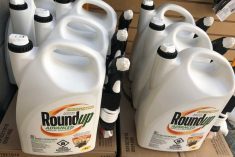Canola crush profits are high, but that’s no reason for growers to break out the champagne, say Alberta producers.
Crush plants are riding a wave of demand and processed about 794,000 tonnes of seed in September, the most in a year. And with crush margins well above $200 per tonne for futures contracts (more than triple what they were a year ago), demand for canola is forecast to remain high.
Although demand from crushers is robust, the impact on prices is hard to know, said John Guelly, a producer from Westlock.
Read Also

Moo translator and methane measures: There’s an app for that
Dalhousie University researchers use artificial intelligence to create new dairy farm apps that analyze cattle sounds and measure methane.
“We’re price takers so generally we don’t see a heck of a lot of difference when the crushing margin goes up,” said Guelly. “It’s just something to keep in the back of your head when you’re marketing, knowing that (the plants) are making money so they’re going to keep crushing as fast as they can and they’re going to need as much as they can to keep the crusher running.
“The more they need, the better off it is for us. Increased demand usually increases the price a bit but there’s never any real direct relationship.”
[RELATED] Tough calls: canola marketing is extra complex in an unstable world
However, it can be different for those located near a crush plant. There are four in Alberta and 11 in Western Canada.
Scott Keller, who grows canola a short drive from Cargill’s crush facility south of Camrose, said he’s been getting a 50 cent per bushel ($22 per tonne) premium over the local elevators, a sum he describes as “pretty darn good.”
“It’s very rare that an elevator (intended) for export markets has a better price than a crushing plant, in my experience,” said Keller. That said, you need to be fairly near the facility, he added.
“If you’ve got an elevator that’s close by and the crush plant’s further away, then once you factor in freight, the elevator might have the better price.”
Like Guelly, Keller noted that farmers are essentially price takers.
“(The plants) can certainly afford to pay more — it’s just whether they’ll have to or not,” he said. “When they’re at a 50-cent premium already, how much higher would they have to be before their margins aren’t very big? I don’t know the answer to that.”
[RELATED] The ball is just getting started for Canada’s Cinderella crop
Still, it’s worthwhile for producers to keep an ear to the ground to learn how much canola the crushers need, he said.
“The crush plants don’t like to start and stop,” said Keller. “If they’re worried about not having enough come in, it’s not uncommon for them to throw out a $10-per-tonne premium for a certain month, run it for a day. And they’ll get enough canola and that’s all they need to do to make sure they can keep crushing canola and have a steady supply.”
That was evident after last year’s drought, when production fell by a third.
“Last year, when canola was so tight, I heard stories of a crush plant actually buying canola from elevators – not even their own company but competitors,” said Keller. “I wouldn’t expect that’s going to happen anymore now that there’s a good local supply of canola. Crops were average or close to average, a lot better than last year.”
Still, prices have remained strong, he noted.
“It’s still a good price when we can get over $20 for canola. We’re at a spot where the average crop generates a profit so things are good.”
One thing is certain, said both Guelly and Keller: Canada, and especially Western Canada, needs more crushing capacity.
Guelly said he’s heard reports that the country’s current crushing infrastructure can only process about 55 per cent of what Canada’s canola producers grew this year.
“That’s going to change when the new crush capacity comes on line in the next couple of years but it looks like demand is good, and when demand is good, that’s usually good for farmers.”
Keller is a little more adamant.
“When crush margins are as high as they are, there’s no excuse not to build more crush plants in Western Canada,” he said. “You should sure expect there to be continued investment in crushing facilities in Western Canada. It only makes sense.”
















